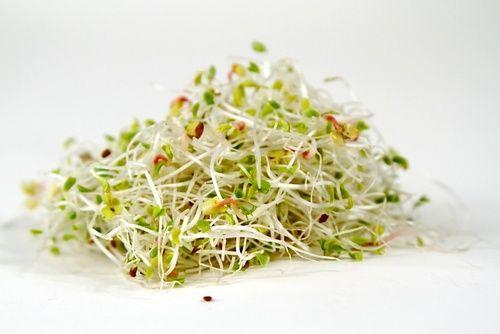I radish sprouts I am an inexhaustible source of vitamin C and mineral salts. They have remineralizing, antiseptic and diuretic properties, also useful in prevention of asthma. Let's find out better.
> Composition of radish sprouts
> Properties and benefits of radish sprouts
> Organoleptic characteristics and uses
> Secrets of sprouting

Description of the radish
The radish is a plant of the Brassicaceae family which includes numerous varieties. The main edible part consists ofroot system, which depending on the cultivar can change in color, flavor, size and shape: it can range from small spherical or heart-shaped roots of a few centitres to white roots over thirty centimeters in length.
Then there are truths from delicate flavor, while others may be markedly love (such as Spanish black radish) or even spicy (like the fire candle).
Composition of radish sprouts
We are talking about a food very rich in vitamin C, B vitamins (in particular B6 or pyridoxine). It excels as resource of mineral salts such as potassium, iron, copper, magnesium and calcium. The seeds contain terpenes and sulfates which give them a horseradish and pungent taste.
Properties and benefits
The intense taste and vitamin C make radish sprouts not only excellent antiscorbutics and expectorants but also an ideal preventive food against asthma, colds, sinusitis and inflammation of the respiratory tract (stimulates the elimination of mucus).
Here are some of the properties attributed to radish sprouts: they are a good remineralizer (ideal for athletes and those who have to fight fatigue); are antiseptics and diuretics, support the work of the kidneys, liver and spleen.
Radish sprouts among the natural remedies for asthma: discover the others

Organoleptic characteristics and uses of radish sprouts
The taste is prickly, the bud body is firm and crunchy, white and violet with small decorative and inviting green leaves. Unlike other delicate-tasting buds that lend themselves well as a neutral base, the radish sprout characterizes the dishes and plays well with strong flavors, so as well as giving depth to salads it is accompanied by dishes of legumes, vegetables such as aubergines and peppers, or dishes based on sauces. With radish sprouts you can make an excellent cream to spread on bruschetta.
Sprouting secrets
I seeds are small, kidney-shaped, brown and striped. Once decided to start the germination, they must be left to soak for about 10 hours. Once drained, they must be placed in a tray to be kept in the refrigerator for a period that can vary from five days to a whole week, changing the water at the base of the tray once a day.
Once developed, they appear twisted, pinkish whites with a small pair of heart-shaped leaves and a light snowy hair near the root system. At this point they must be consumed within four days, always keeping them at the temperature of the refrigerator.
READ MORE
How to eat sprouts: raw and cooked preparations
Other articles on sprouts:
> Sprouts among the Kousmine ingredients
| Sunnycreekfarm.com


























